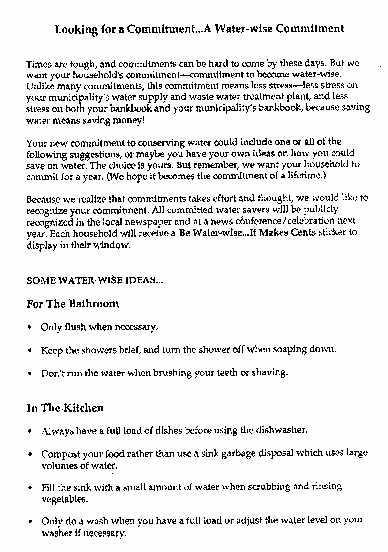Be Water Wise. It Makes Cents
To promote water efficiency and reduce water consumption, residents were offered home visits conducted by trained volunteers and the opportunity to obtain discounts on home water-saving devices.
Background
In April 1996, The Clean Nova Scotia Foundation launched the Be Water Wise ... It Makes Cents program in response to concerns about diminishing supplies of clean water. It was implemented in the three municipalities of Sackville, Bedford (urban) and New Glasgow (rural), with a total population of 55,000.
Getting Informed
To test their assumption that cost and convenience could be barriers to participating in a water conservation program, The Clean Nova Scotia Foundation conducted preliminary research through the Internet to investigate other water conservation programs that had been implemented in Canada and the United States. This research substantiated their assumptions, so the program was designed to minimize or eliminate these barriers.
Originally, the Be Water Wise ... It Makes Cents program was to include kits containing only low-flow shower heads and faucet aerators. The program was modified to include the ultra low-flow toilets when research revealed that water consumption could be reduced by 20 percent in homes which installed these water-saving devices.
Delivering the Program
The campaign began with a news conference on Earth Day, April 22, 1996, during which organizers displayed and described the water saving devices. Local radio and television stations aired news releases, public service announcements, interviews and quizzes. Local newspapers featured stories about "waste-wise" families, and printed much of the same information covered by radio and television. The program was also promoted in the three municipalities' newsletters. Inserts were included in telephone and power bills.
An Internet Web site provided information on the program, and further information was provided at Bedford Days, Arbor Day, Canada Day, as well as at home shows. Community centres, public libraries, museums, and The Clean Nova Scotia Foundation affiliates (Bedford and New Glasgow EnviroTown Programs) were also provided with information.
One hundred households selected from each of the three communities received a 10-minute home visit conducted by trained volunteers (Home Visits). During this visit the program was outlined and an information package on water conservation delivered. The package contained an explanation of the program, a fact sheet on waste reduction, a brochure explaining why and how to conserve water in the home, and a program sign to post in the window (Norm Appeals and Building Motivation Over Time).
Following this, participants were asked to sign a commitment form stating that they would reduce water consumption for one year. The participants were told that all committed water-savers would be publicly recognized in the local newspaper and at a news conference the next year (Obtaining a Commitment).
Ninety-two participants from this group signed commitment forms. People commented that the form was too long and complicated.
A second group of 300 households (100 from each community) were given the opportunity to receive a retrofit kit in addition to a 20-minute home visit and the information package. The retrofit kit offered participants a rebate of $9 per low-flow shower head, $5 per faucet aerator, $177 per ultra low-flow toilet and $30 per toilet installation (Financial Incentives and Disincentives). The total cost per household was estimated to be $219 before the rebate; $75 plus tax after the rebate. Since running the program, The Clean Nova Scotia Foundation decided that it would be more cost effective to pay the rebates through the local water utility bill. This would reduce the administrative and accounting costs of issuing rebates by combining them with an existing billing system.
These rebates were used to overcome the cost barrier identified in the initial research. The convenience barrier was addressed by the home visits and by providing a list of approved plumbers who could install the toilets (Overcoming Specific Barriers). Following the home visit, a public commitment to reduce water consumption for one year was also requested from this group.
Financing the Program
The budget for the Be Water Wise ... It Makes Cents program was $45,000. Operating costs amounted to $30,000, as follows:
| Salaries | $ 15,000 |
| Printed material | $ 600 |
| Advertising | $ 4,400 |
| Other | $10,000 |
The cost of subsidies for the water-saving devices was $15,000.
Measuring Achievements
Water consumption levels were measured for two months preceding the program launch, and periodically throughout the program.
Participants were randomly selected from each of the three municipalities. A third group of 300 randomly selected residents served as a control group, who did not receive a home visit and were not asked to make a commitment to the program. Their only source of information about the Be Water Wise program was the public education campaign.
All the participants were asked to complete a telephone survey at the end of the summer of 1996. This survey measured changes in attitudes and water consumption behaviour.
Results
The response to the retrofit kit approach was poor. Apparently, the public education campaign had not adequately prepared residents who were visited to consider purchasing the water-saving devices. When they were later offered to all residents in the three communities through a message printed on their water utility bill, the remaining kits were sold.
The Clean Nova Scotia Foundation felt that a stronger education campaign would result in more interest in water conservation and the installation of water-saving devices. They expressed that, in future, they would like to allocate more money toward education.
At the time of writing, this project was still ongoing. The results to date have not shown any significant reductions in water usage, relative to the control group.
Contacts
Steve Machat
Executive Director
Clean Nova Scotia
126 Portland Street
Dartmouth, NS
B2Y 1H8
(902) 420 3476
Email: CNS@clean.ns.ca
Web Site: www.clean.ns.ca
Notes
Last revised: July, 2004
This case study was originally published in 1998 in "Tools of Change: Proven Methods for Promoting Environmental Citizneship" by Jay Kassirer and Doug McKenzie-Mohr (Published by Canada's National Round Table on the Environment and the Economy)
Search the Case Studies


